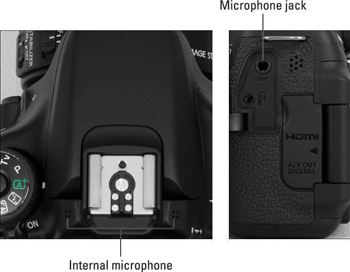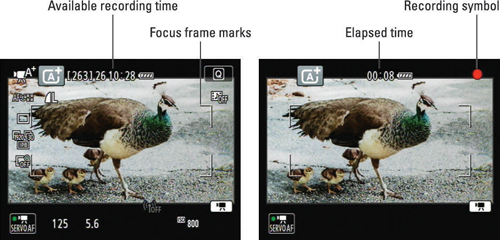How to Continue Recording on Canon Eos 70d After 30 Minutes
By moving the Live View switch to the Movie position, you can record high-definition video with your Canon EOS 70D, with or without sound. The camera records movies in the MOV format, which is a popular file format for storing digital video. Movie filenames begin with the characters MVI_.
For best recording results, use a high-speed memory card (class 10 or UHS-1). With slower cards, the camera may not be able to write the movie data to the card fast enough to keep pace with recording. If this happens, a vertical bar appears on the right side of the screen to indicate how much data is yet to be sent to the card. When the indicator appears full, movie recording is halted automatically.
Assuming that your card is fit for the job, recording a movie using the default settings is a cinch:
-
Disable the Wi-Fi function via Setup Menu 3.
You can't record a movie while the Wi-Fi feature is turned on.
-
To use an external microphone, plug the mic into the port on the left side of the camera.
Otherwise, sound is recorded via the internal microphone, positioned in the location shown on the left in the figure below. Plug an external mic into the jack labeled on the right in the figure.

-
Set the Mode dial to Scene Intelligent Auto (the green A+).
In this mode, the camera handles all exposure settings for you, which is the way to go unless you're an experienced videographer.
-
Set the Live View switch to the Movie setting.
The viewfinder shuts off, and the live preview appears on the monitor. You see various data onscreen, as shown on the left in the following figure. The critical detail is the available recording time, which depends on how much free space exists on your memory card and the Movie Recording Size setting, which determines the movie file size.

The display shows how many minutes of video will fit on your memory card (left) and, after you begin recording, elapsed recording time (right).
-
Frame your initial shot and set focus.
By default, the camera uses continuous autofocusing (Movie Servo AF) and the Face+Tracking AF mode. If the camera detects a face, it automatically focuses on that face; otherwise, it shifts to FlexiZone-Multi AF mode and typically focuses on the closest object found within the framing marks labeled in the above figure.
To use manual focusing, first shift back to viewfinder shooting and then move the lens switch to the MF position. (This step prevents possible damage that can occur if you move the switch while continuous autofocusing is in progress.) Return to Movie mode and bring the subject into focus using the lens focusing ring.
-
To start recording, press the Start/Stop button.
Most shooting data disappears, and a red "recording" symbol appears, as shown on the right in the above figure. Now, instead of showing you the length of the recording that will fit on your memory card, the display shows the elapsed recording time.
The maximum movie length at the default recording settings is 16 minutes, which is how long it takes for the file to reach 4 gigabytes (GB), the file size limit. When you reach that limit, the camera creates a new movie file to hold the next 16 minutes of video. Recording stops automatically when the total recording time reaches 29 minutes and 59 seconds.
To reset focus during recording, press the AF-ON button.
-
To stop recording, press the Start/Stop button again.
At the default settings, your movie is recorded using the following settings:
-
Full HD video quality (1920 x 1080p, or pixels) at 30 frames per second (fps), using the IPB compression setting
-
Audio recording enabled
-
Evaluative (whole frame) exposure metering
-
Automatic white balancing
-
Auto Lighting Optimizer applied at the Standard setting
-
Auto Picture Style
About This Article
This article is from the book:
- Canon EOS 70D For Dummies ,
This article can be found in the category:
- Canon ,
Source: https://www.dummies.com/article/home-auto-hobbies/photography/cameras/canon/how-to-record-a-movie-with-a-canon-eos-70d-158324/
0 Response to "How to Continue Recording on Canon Eos 70d After 30 Minutes"
Postar um comentário